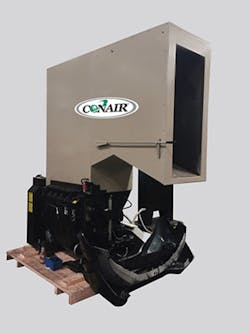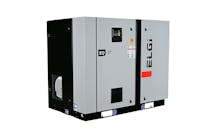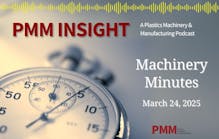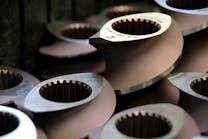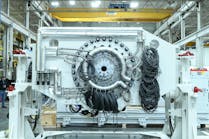Most plastics processes have scrap left over from the production process, excepting a few like hot runner injection molding, which produces little to no scrap. The rest make scrap, and something has to be done with it.
The process of recycling plastic scrap may seem straightforward. Throw it in and grind it. However, recycling increasingly is requiring a knowledge of where the material has been and where it is going, its viscosity, heat history and other characteristics.
Granulators, shredders, and some hybrids of the two are the primary pieces of equipment used to reduce the scrap to smaller volumes so it can be reprocessed or hauled away, if necessary. Granulators typically grind chunks of plastic into beads of a specific size that will go through a screen beneath the rotor unit. Shredders cut scrap material into manageable strips for further use or disposal.
Raw scrap has to be moved to these machines, and the processed scrap has to go somewhere, giving rise to the need for conveyors or other transport systems. Furthermore, contaminants have to be removed with magnetic devices and other systems. All told, dealing with scrap is an important but not necessarily easy process.
Companies have put equipment in place to help them meet the latest challenges of dealing with scrap from their processes. Recycling equipment suppliers can make themselves useful in consulting about recycling issues, if the processor is open to that. A processor can buy a granulator, bolt it to the floor and start using it, but getting some guidance from the recycling equipment supplier might be a better idea.
AUTOMOTIVE BUMPER MOLDER
Custom Conair hopper design
Large automotive components such as bumper fascias pose special recycling challenges. One fascia producer follows a corporate environmental policy of reusing as much process scrap as possible. When fitting out a new plant to mold bumper fascias, the firm asked Conair Group, Cranberry Township, Pa., to recommend a central granulator.
In all of its plants, the producer (whose name Conair was not at liberty to disclose) grinds and reuses unpainted scrap in-house, but painted components are stripped and ground by an outside contractor. Some of this material is molded into non-appearance parts by an outside firm, and the remainder is sold. In the new plant, however, the Conair granulators would be required to handle not only the unpainted scrap, but also the painted components.
Usually, large bulky scrap like a bumper fascia would require a big granulator like the Conair Model CKW, which has an in-feed opening as much as 8 feet off the plant floor. A conveyor would normally do the feeding and installation would require substantial floor space. Conair determined that the volume of material and the thickness of the part could be handled easily by a smaller unit, if there was a way to feed the bumpers in a controlled manner.
The result was a Conair Model CW super-tangential granulator with a specially designed hopper. In operation, parts are hand-placed into the feed opening and the operator moves a lever on the hopper's side to tilt the bumper up so it slides neatly into the cutting chamber. The narrow hopper opening and assisted loading feature essentially eliminate the possibility of a misfeed and ensure clean, efficient size reduction. The granulator has a footprint of just 68 by 75 inches, almost half of what would be required by the larger CKW unit. Because no conveyor is used, floor-space requirements are reduced even further.
Today the company granulates both painted and unpainted bumpers, which eliminates shipping costs associated with sending painted regrind out for stripping. Instead of being sold at reduced prices, the scrap is returned to the plant and mixed with virgin material to a desired ratio. Cost analysis for the new plant shows that being able to reuse the painted scrap can save $50,000 per year, and savings arising from reclaiming the unpainted scrap could be even greater.
BUTLER-MACDONALD
Heavy-duty Herbold equipment
Industrial recycler Butler-MacDonald Inc., Indianapolis, sees itself as willing to go beyond standard assumptions about the value of plastic waste. Working with manufacturers, prime resin producers, plastics brokers, and even other recyclers, the company recovers high-quality polymers, achieving yields, purities and separations not ordinarily expected.
Although some aspects of the firm's processes are proprietary, the formula for success is straightforward: creative engineering, stringent laboratory controls and high-quality equipment.
J. Scott Johnson, Butler-MacDonald's president, CEO, and chief system designer, says the company is getting more challenging work.
"As people do more and more recycling, digging deeper into the pile, if you will, they're ending up with more difficult things to recycle. So that's where some of our growth has come from — difficult work is our forte," he said. Butler-MacDonald customers include plastics compounders, telecommunications companies, and producers of CDs and DVDs, aeronautical and auto parts, vinyl siding and windows, PET bottles, and pharmaceuticals.
That increase in business requires a granulator. So to get the job done Butler-MacDonald uses an SMS 80/120 granulator from Herbold Meckesheim GmbH. The German machinery company's U.S. subsidiary is Herbold Meckesheim USA Resource Recycling Systems Inc. of North Smithfield, R.I.
The SMS 80/120 granulator has a large, 36- by 45-inch feed opening, which helps Butler-MacDonald achieve throughput capacities of up to 9,000 pounds per hour. Butler-MacDonald uses the heavy-duty SMS 80/120 because it has features like a sturdy welded-steel construction and external rotor bearings (so no material gets into the bearings and no grease into the product).
The machine also has energy-efficient double crosscutting action and a deflection wedge that can be removed to accommodate large objects like refrigerator housings and other major appliances. The line is equipped with a metal-detecting feed conveyor. Butler-MacDonald also uses another Herbold machine —a T1015 mechanical dryer/centrifugal washer. The unit can be used as an intensive washer and a dryer for film, regrind and mixed plastics.
ENGINEERED RECYCLING CO.
Vecoplan shredders
The Engineered Recycling Co. LLC (ERC) processing plant in Charlotte, N.C., recycles HDPE, including bottles and intermediate bulk container scrap. The scrap is converted to pellets for the post-industrial HDPE market.
ERC uses shredders from Vecoplan LLC, Archdale, N.C. Material for recycling comes into the plant from multiple sources and is put through magnetic systems for ferrous metal removal.
Two Vecoplan VAZ 2500-T shredders are a part of the operation. The rotors are 98 inches wide and 25 inches in diameter. Cutters number 171 and each measures 40mm square.
The Vecoplan HiTorc electromagnetic drive provides high torque values. Speed range is 30 to 300 rpm. Speed selection is continuous, at the discretion of the operator, who has the option to have the machine perform a controlled stop or reverse.
The drive is rated at 300 horsepower, and pulls under 10 amps of electric current at idle, contributing to energy savings. In normal operations the operator sets the speed of the machine according to the specific characteristics of the material being shredded. The Vecoplan technology fits well into systems that need to be easily changed from processing one material to another.
Merle R. Snyder, senior correspondent



